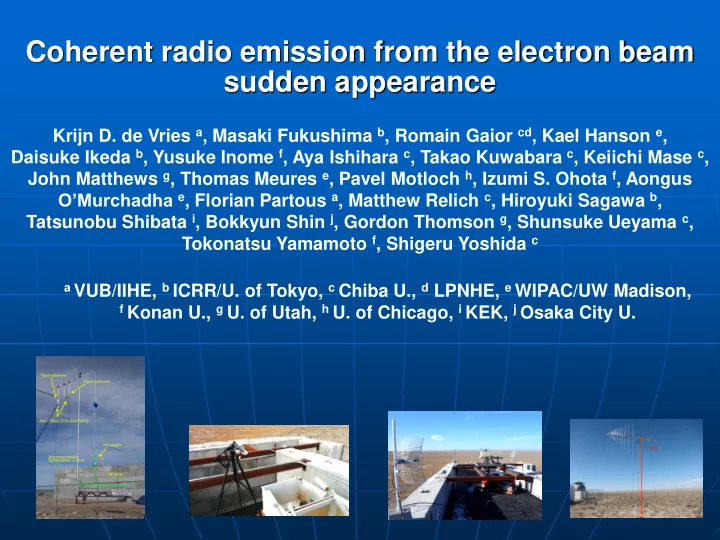

Coherent radio emission from the electron beam sudden appearance Krijn D. de Vries a , Masaki Fukushima b , Romain Gaior cd , Kael Hanson e , Daisuke Ikeda b , Yusuke Inome f , Aya Ishihara c , Takao Kuwabara c , Keiichi Mase c , John Matthews g , Thomas Meures e , Pavel Motloch h , Izumi S. Ohota f , Aongus O’Murchadha e , Florian Partous a , Matthew Relich c , Hiroyuki Sagawa b , Tatsunobu Shibata i , Bokkyun Shin j , Gordon Thomson g , Shunsuke Ueyama c , Tokonatsu Yamamoto f , Shigeru Yoshida c a VUB/IIHE, b ICRR/U. of Tokyo, c Chiba U., d LPNHE, e WIPAC/UW Madison, f Konan U., g U. of Utah, h U. of Chicago, i KEK, j Osaka City U. 1
Experimental setup The TA-ELS Electron Beam ~10 9 (40 MeV) electrons ~ 40 PeV 1
Experimental Setups 1.4-3 GHz In-ice Radar 50-66 MHz In-air Radar 230-400 MHz 12.5 GHz Askaryan 2 Molecular Bremsstrahlung
Experimental setup Credits: Romain Gaior 3
Results and Coherence 50 MHz 230-430 MHz Power Density: Power Density: P=1.002 +- 0.014 (stat) +5.17 – 0.56 P=O(10^-24 – 10^-25) ; Freq dependent, (sys) [10^-24 J/m^2/Hz/pC^2] see next slide Charge dependence P~(Q^S): Charge dependence P~(Q^S): S = 1.639 +- 0.415 S= 1.87 +- 0.01 4
Results and Coherence 1.4-3 GHz 12.5 GHz Power Density: Power Density: P=O(10^-27); Freq Dep. P=8.46 +- 0.13(stat) +- 4.27 (sys) See next slide [10^-29 J/m^2/Hz/pC^2] Charge dependence P~(Q^S): Charge dependence P~(Q^S) S=1.93 +- O(0.1) S= 2.16 +- O(0.2) 5
Results: Angular distribution (230-430 MHz) Simulation (grey band) agrees very well to data (black dots). See talk Keiichi Mase last Friday. 6
Modeling the Beam sudden appearance: Coherent Transition Radiation D: Apparent relativistic (four) distance --> Undefined at a boundary. Coherent TR can be described as the superposition of emission just above and below the boundary. Particle Cascade 7
Modeling the Beam sudden appearance: Coherent Transition Radiation D: Apparent relativistic (four) distance --> Undefined at a boundary. Coherent TR can be described as the superposition of emission just above and below the boundary. Particle Cascade 7
Modeling the Beam sudden appearance: Coherent Transition Radiation D: Apparent relativistic (four) distance --> Undefined at a boundary. Coherent TR can be described as the superposition of emission just above and below the boundary. Particle Cascade 7
Modeling the Beam sudden appearance: Coherent Transition Radiation 0 D: Apparent relativistic (four) distance --> Undefined at a boundary. Coherent TR can be described as the superposition of emission just above and below the boundary. Emission absorbed / shifted outside the coherent frequency band 8
What do we expect to observe? The Beam characteristics ~10 9 (40 MeV) electrons ~ 40 PeV 9
Simulation Results: The sudden appearance energy density spectrum Coherence over bunch width Coherence over sub-bunch width 10
(Qualitative) Results: The sudden appearance energy density spectrum Four experiments observed the sudden appearance signal in different frequency ranges 50-66 MHz 1.4-3 GHz 230-430 MHz 12.5 GHz 11
Applications in nature: Astropart.Phys. 74 (2016) 96-104 arXiv:1503.02808 ʋ Phys. Rev. D 95, 043004 (2017) arXiv:1606.07059 12
Summary - We report on the measurement of coherent radio emission from the electron beam sudden appearance. - The signal is observed over a wide range of frequencies from 50 MHz – 12.5 GHz. - All measurements show a high-level of coherence. - The power density spectrum directly reflects the electron beam profile, and matches the simulations both qualitatively and quantitatively (still preliminary). The signal is well understood. - The in-nature application is found in high-energy particle cascades traversing different media. 10
Recommend
More recommend